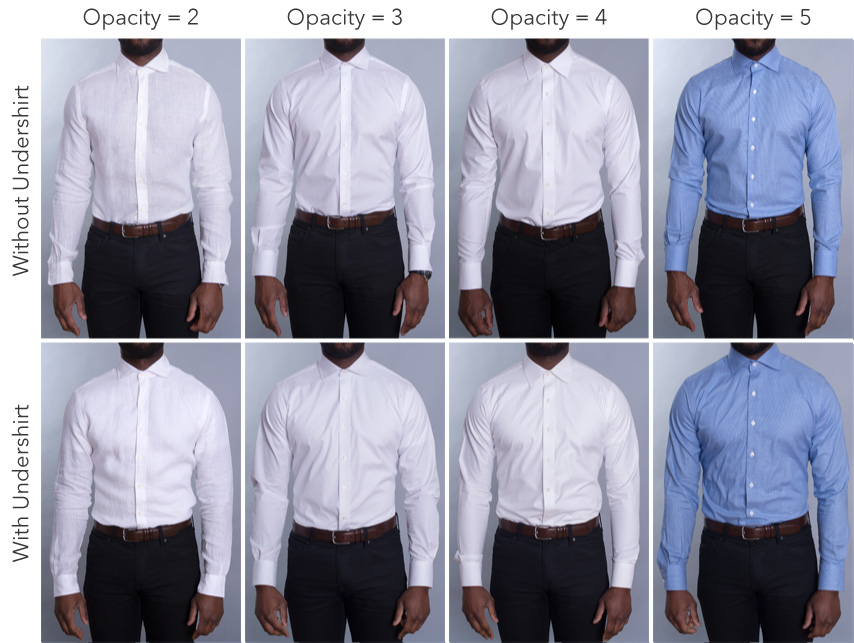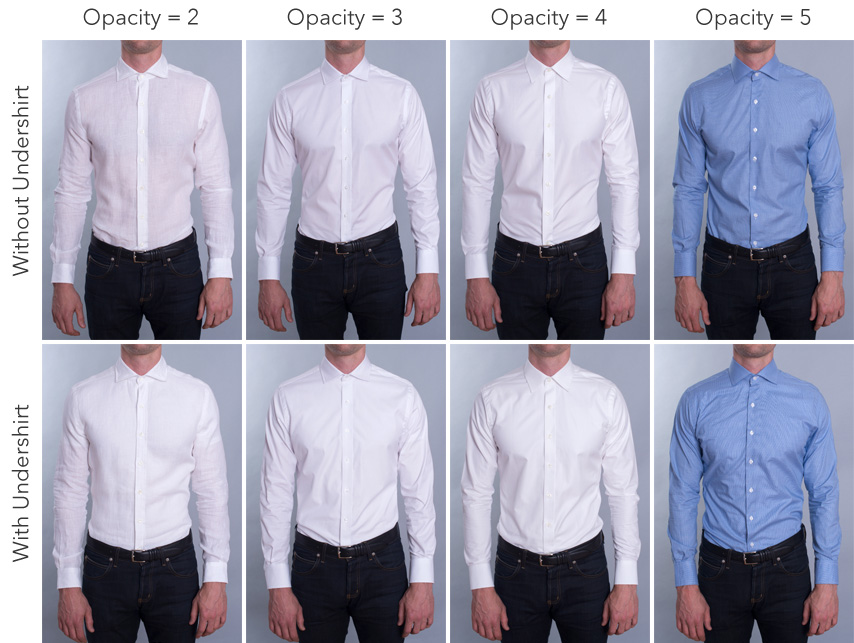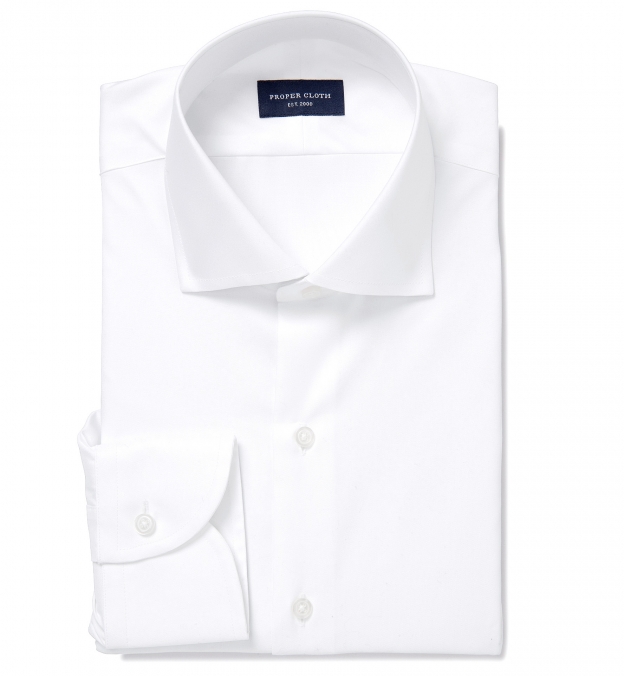Proper Cloth’s Opacity Ratings:
We rate each of our fabrics in terms of its opacity to give customers a good idea of what to expect from them. We do this on a 1-5 scale, with 1 being the least opaque and 5 being the most opaque.
5 – Maximum Opaqueness
We don’t expect anyone to have an issue with the opacity of this fabric. It shouldn’t show through and should retain its color regardless of the color of the skin or hair below the fabric.
An example of a 5/5 rating would be our Black Heavy Oxford (PCF1112).
4 – Very Opaque
Our 4/5 opacity rating is our most popular rating. We rarely have issues with customers finding these fabrics to be sheer. Most non-white or patterned fabrics will be in this category.
An example of a 4/5 opacity rating is our Mayfair Wrinkle-Resistant Light Blue Houndstooth – PCF1986. The subtle houndstooth pattern, twill weave, and light blue color create a visual effect that makes this more opaque than if it were non-patterned or if it were a white fabric of the same weight.
3 – Fairly Opaque
This is where many of our white or light blue solid fabrics fall. Most guys shouldn’t have opacity issues with these, but if you’re the type who knows he wants a particularly opaque fabric then we suggest opting for a fabric with a 4/5 or 5/5 rating.
An example of a 3/5 opacity rating is our Non-Iron Supima White Pinpoint Fabric – PCD001. This is a medium to lightweight white pinpoint, so because it has no pattern or color it will be more likely to show through. We’ve had some customers who are particularly sensitive to opacity find this fabric to be a little too sheer for their preference.
2 – Slightly Transparent
These fabrics are generally lightweight summer fabrics, often made with a looser weave and/or linen. Typically, these are the most breathable shirts and can be super comfortable in the summer, but you have to be okay with them showing through in certain situations.
An example of a 2/5 opacity rating is our Thomas Mason White Luxury Broadcloth – PCF1615. It’s a very lightweight fabric that you will be able to see your skin color through when you’re not wearing an undershirt. If transparency is a concern for you, we suggest avoiding fabrics with a 2/5 opacity rating.
1 – Very Transparent
The very transparent fabrics we carry are much like the slightly transparent fabrics in that they are lightweight and made with looser weaves and/or linen. They are also generally white, which is the easiest color to see through. These fabrics are also usually quite casual in nature.
An example of a 1/5 opacity rating is our Baird McNutt White Irish Linen – PCF3009. The light weight of this fabric contributes to its breathability, but, in combination with its white color, makes it very transparent. If transparency is a concern for you, we suggest avoiding fabrics with a 1/5 opacity rating.


A Very Opaque White Shirt
A luxurious, densely woven twill that’s perfect for a big event. This one is a very unique style we specifically selected for its opacity and clean drape. Thomas Mason uses a special 120s 3-ply construction to achieve this performance. Because the weave is fine, it appears totally clean and without texture from a distance, while the twill gives it that pinch of shine that gives a white shirt remarkable vibrance. Medium-heavyweight thickness, 4/5 opacity rating—this is the most opaque, plain white office or formal shirt you will find.
Thomas Mason White 3 Ply Regal Twill

Opacity – An Overview
Shirts can be made from a wide variety of fabrics—from thick heavy flannels to the thinnest cotton and linen blends. Typically, weight and color dictate the opacity of a fabric. The thicker a fabric is the more opaque it will be, and the closer to white a color is the more it will show through.
These aren’t the only considerations, though. The weave of a fabric and type of yarn used can come into play. Shirts with wool woven into them almost always tend to be more opaque, whereas 100% linen or cotton/linen shirts tend to be more sheer. Additionally, a fabric can be more or less opaque depending on whether it’s an oxford, a pinpoint, a twill, a broadcloth, or a jacquard.
Twills are some of the most dense weaves, so they will often be more opaque than oxfords and pinpoints of similar weights, which are woven a little more “loosely” or are what’s called “open.” Broadcloth (or poplin) is more difficult to weave with a very high density, so most broadcloths will tend to weigh less than twills, oxfords, and pinpoints. Because of this, broadcloth is generally the least opaque fabric weave type.
While many guys will never have an issue with opacity, there are some who find this to be the most important aspect of their shirt. Those with darker skin, or guys with (especially) hairy chests are most likely to have issues with fabrics showing through.
- Dress Shirt Fabrics Overview Here we provide the definitive overview of the different types of fabrics commonly used in dress shirts. By understanding what the different weaves mean for a fabric you...
- Glossary Acala Cotton: A Mexican variety of cotton that was introduced into the United States. This type of cotton is currently also grown in the southwestern states and Israel....
- Wrinkle Resistance Ratings Wrinkle resistance is entirely a matter of personal preference. Some guys will want their shirts to look freshly-pressed at all times, while others may not mind the lived-in...
- The Perfect Wedding Dress Shirt The Big Day is coming up and you need to look your best. You’ll never have as many friends around, or as many photos taken, as you will...